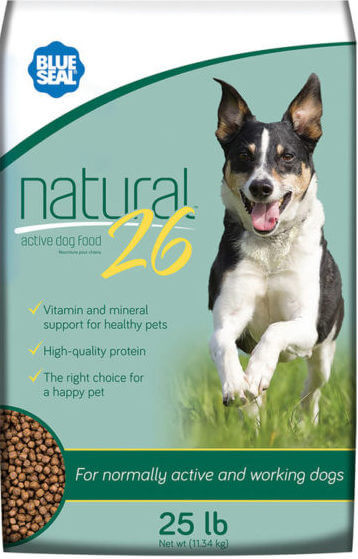
DogFoodAdvisor is reader supported See how
All reviews are 100% impartial but if you buy using links on this page, we may earn a referral fee.
Review of Blue Seal Classics Dry Dog Food
Blue Seal Classics Dog Food receives the Advisor’s mid-tier rating of 3.5 stars.
The Blue Seal Classics product line includes the 2 dry dog foods listed below.
Each recipe includes its AAFCO nutrient profile when available… Growth (puppy), Maintenance (adult), All Life Stages, Supplemental or Unspecified.
| Product | Rating | AAFCO |
|---|---|---|
| Blue Seal Krunchies | 3 | M |
| Blue Seal Natural 26 | 3.5 | M |
Recipe and Label Analysis
Blue Seal Natural 26 was selected to represent both products in the line for detailed recipe and nutrient analysis.
Label and nutrient data below are calculated using dry matter basis.
Blue Seal Natural 26
Estimated Dry Matter Nutrient Content
Protein
Fat
CarbsCarbohydrates
Pork meat and bone meal, ground corn, ground wheat, corn gluten meal, chicken fat (mixed tocopherols preservative), dried beet pulp, natural flavor, yeast culture, potassium chloride, salt, calcium carbonate, choline chloride, vitamin E supplement, selenium yeast, zinc sulfate, manganese sulfate, zinc proteinate, ferrous sulfate, manganese proteinate, copper proteinate, copper sulfate, l-ascorbyl-2-polyphosphate (source of vitamin C), dl-methionine, niacin supplement, biotin, vitamin A supplement, sodium selenite, d-calcium pantothenate, thiamine mononitrate, riboflavin supplement, pyridoxine hydrochloride, vitamin D3 supplement, vitamin B12 supplement, calcium iodate, folic acid, mixed tocopherols (preservative), citric acid (preservative), rosemary extract
Fiber (estimated dry matter content) = 4%
Red denotes any controversial items
| Estimated Nutrient Content | |||
|---|---|---|---|
| Method | Protein | Fat | Carbs |
| Guaranteed Analysis | 26% | 12% | NA |
| Dry Matter Basis | 30% | 14% | 49% |
| Calorie Weighted Basis | 27% | 30% | 44% |
Ingredient Analysis
The first ingredient in this dog food is pork meat and bone meal, a dry “rendered product from (pork) tissues, including bone, exclusive of any added blood, hair, hoof, horn, hide trimmings, manure, stomach and rumen contents”.1
Pork and bone meal may have a lower digestibility than most other meat meals.
Scientists believe this decreased protein quality may be due to the ingredient’s higher ash and lower essential amino acid content.2
On the brighter side, pork and bone meals are meat concentrates and contain nearly 300% more protein than fresh pork.
The second ingredient is corn. Corn is an inexpensive and controversial cereal grain. And aside from its energy content, this grain is of only modest nutritional value to a dog.
The next ingredient is wheat. Wheat is another cereal grain and subject to the same issues as corn (previously discussed).
The fourth ingredient is corn gluten meal. Gluten is the rubbery residue remaining once corn has had most of its starchy carbohydrate washed out of it.
Although corn gluten meal contains 60% protein, this ingredient would be expected to have a lower biological value than meat.
And less costly plant-based products like this can notably boost the total protein reported on the label — a factor that must be considered when judging the actual meat content of this dog food.
The fifth ingredient is chicken fat. This item is obtained from rendering chicken, a process similar to making soup in which the fat itself is skimmed from the surface of the liquid.
Chicken fat is high in linoleic acid, an omega-6 fatty acid essential for life. Although it doesn’t sound very appetizing, chicken fat is actually a quality ingredient.
The next ingredient is beet pulp. Beet pulp is a controversial ingredient, a high fiber by-product of sugar beet processing.
Some denounce beet pulp as an inexpensive filler while others cite its outstanding intestinal health and blood sugar benefits.
We only call your attention here to the controversy and believe the inclusion of beet pulp in reasonable amounts in most dog foods is entirely acceptable.
After the natural flavor, we find yeast culture. Although yeast culture is high in B-vitamins and protein, it can also be used as a probiotic to aid in digestion.
From here, the list goes on to include a number of other items.
But to be realistic, ingredients located this far down the list (other than nutritional supplements) are not likely to affect the overall rating of this Blue Seal product.
With 3 notable exceptions…
First, we find no mention of probiotics, friendly bacteria applied to the surface of the kibble after processing to help with digestion.
Next, this food contains chelated minerals, minerals that have been chemically attached to protein. This makes them easier to absorb. Chelated minerals are usually found in better dog foods.
And lastly, this recipe includes selenium yeast. Unlike the more common inorganic form of selenium (sodium selenite), this natural yeast supplement is considered a safer anti-cancer alternative.
Nutrient Analysis
Based on its ingredients alone, Blue Seal Classics Dog Food looks like a below-average dry product.
The dashboard displays a dry matter protein reading of 30%, a fat level of 14% and estimated carbohydrates of about 49%.
As a group, the brand features an average protein content of 27% and a mean fat level of 13%. Together, these figures suggest a carbohydrate content of 53% for the overall product line.
And a fat-to-protein ratio of about 47%.
Above-average protein. Below-average fat. And above-average carbs when compared to a typical dry dog food.
When you consider the protein-boosting effect of the corn gluten meal, this looks like the profile of a kibble containing a moderate amount of meat.
Our Rating of Blue Seal Classics Dog Food
Blue Seal Classics is a grain-inclusive dry dog food using a moderate amount of named meat and by-product meals as its main source of animal protein, thus earning the brand 3.5 stars.
Recommended.
Has Blue Seal Brand Dog Food Been Recalled?
The following automated list (if present) includes all dog food recalls since 2009 related to Blue Seal.
No recalls noted.
You can view a complete list of all dog food recalls since 2009 here.
Get Free Recall Alerts
Get free dog food recall alerts sent to you by email. Subscribe to The Advisor’s recall notification list.
More Blue Seal Brand Reviews
The following Blue Seal dog food reviews are also posted on this website:
Compare This Dog Food
How does this brand compare with The Dog Food Advisor's most recommended brands?
Sources
A Final Word
The Dog Food Advisor does not accept money, gifts, samples or other incentives in exchange for special consideration in preparing our reviews.
However, we do receive a referral fee from online retailers (like Chewy or Amazon) and from sellers of perishable pet food when readers click over to their websites from ours. This helps cover the cost of operation of our free blog. Thanks for your support.
For more information, please visit our Disclaimer and Disclosure page.









